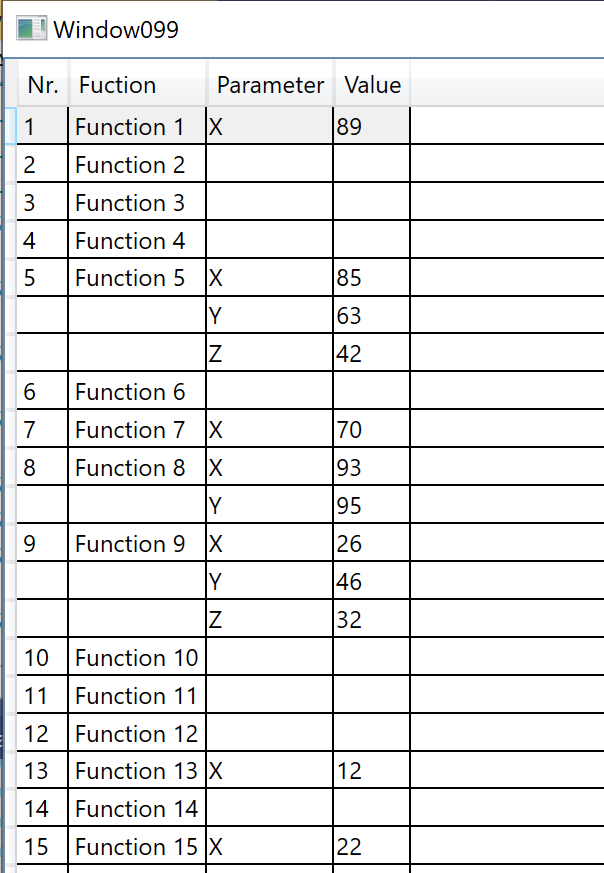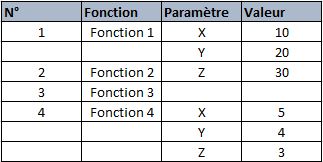Hi Anthony,
you can use additional list for view like in following demo.
XAML:
<Window x:Class="Window099"
xmlns="http://schemas.microsoft.com/winfx/2006/xaml/presentation"
xmlns:x="http://schemas.microsoft.com/winfx/2006/xaml"
xmlns:d="http://schemas.microsoft.com/expression/blend/2008"
xmlns:mc="http://schemas.openxmlformats.org/markup-compatibility/2006"
xmlns:local="clr-namespace:WpfApp1.WpfApp099"
mc:Ignorable="d"
Title="Window099" Height="450" Width="800">
<Window.DataContext>
<local:ViewModel/>
</Window.DataContext>
<Grid>
<DataGrid ItemsSource="{Binding View}" AutoGenerateColumns="False" CanUserAddRows="false">
<DataGrid.Columns>
<DataGridTextColumn Header="Nr." Binding="{Binding Nr}"/>
<DataGridTextColumn Header="Fuction" Binding="{Binding Funk}"/>
<DataGridTemplateColumn Header="Parameter">
<DataGridTemplateColumn.CellTemplate>
<DataTemplate>
<TextBlock Text="{Binding Par}"/>
</DataTemplate>
</DataGridTemplateColumn.CellTemplate>
</DataGridTemplateColumn>
<DataGridTemplateColumn Header="Value">
<DataGridTemplateColumn.CellTemplate>
<DataTemplate>
<TextBlock Text="{Binding ParValue}"/>
</DataTemplate>
</DataGridTemplateColumn.CellTemplate>
</DataGridTemplateColumn>
</DataGrid.Columns>
</DataGrid>
</Grid>
</Window>
and classes:
Imports System.Collections.ObjectModel
Imports System.ComponentModel
Namespace WpfApp099
Public Class ViewModel
' generate demo data
Public Sub New()
For i = 1 To 20
Dim d As New Data1 With {.Nr = i, .Funk = $"Function {i}"}
If rnd.NextDouble < 0.5 Then
d.Functions.Add(New Data2 With {.Par = "X", .ParValue = rnd.Next(10, 100).ToString})
If rnd.NextDouble < 0.6 Then
d.Functions.Add(New Data2 With {.Par = "Y", .ParValue = rnd.Next(10, 100).ToString})
If rnd.NextDouble < 0.7 Then
d.Functions.Add(New Data2 With {.Par = "Z", .ParValue = rnd.Next(10, 100).ToString})
End If
End If
End If
col.Add(d)
Next
End Sub
Private rnd As New Random
Private col As New ObservableCollection(Of Data1)
Private cvs As New CollectionViewSource
' convert demo data to viewed data
Public ReadOnly Property View As ICollectionView
Get
Dim col3 As New ObservableCollection(Of Data3)
cvs.Source = col3
For Each d1 In col
Dim d As New Data3 With {.Nr = d1.Nr.ToString, .Funk = d1.Funk}
If d1.Functions.Count > 0 Then
d.Par = d1.Functions(0).Par
d.ParValue = d1.Functions(0).ParValue
End If
col3.Add(d)
For i = 1 To d1.Functions.Count - 1
col3.Add(New Data3 With {.Par = d1.Functions(i).Par, .ParValue = d1.Functions(i).ParValue})
Next
Next
cvs.Source = col3
Return cvs.View
End Get
End Property
End Class
Public Class Data1
Public Property Nr As Integer
Public Property Funk As String
Public Property Functions As New List(Of Data2)
End Class
Public Class Data2
Public Property Par As String
Public Property ParValue As String
End Class
Public Class Data3
Public Property Nr As String
Public Property Funk As String
Public Property Par As String
Public Property ParValue As String
End Class
End Namespace
Result:


